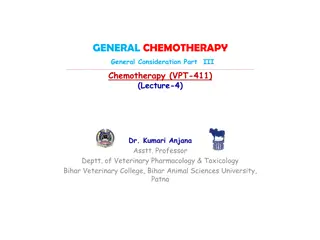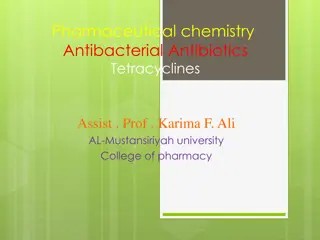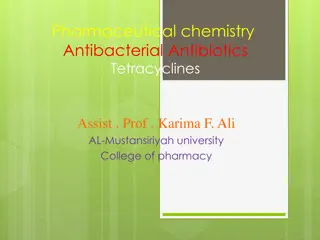
Tetracycline: Mechanism of Action and Classification
Discover the mechanism of action of tetracycline antibiotics, their classification based on source, spectrum of activity, and how they work on bacterial ribosomes. Explore the world of tetracyclines in this comprehensive guide.
Download Presentation

Please find below an Image/Link to download the presentation.
The content on the website is provided AS IS for your information and personal use only. It may not be sold, licensed, or shared on other websites without obtaining consent from the author. If you encounter any issues during the download, it is possible that the publisher has removed the file from their server.
You are allowed to download the files provided on this website for personal or commercial use, subject to the condition that they are used lawfully. All files are the property of their respective owners.
The content on the website is provided AS IS for your information and personal use only. It may not be sold, licensed, or shared on other websites without obtaining consent from the author.
E N D
Presentation Transcript
Classification on the basis of Classification on the basis of source source Natural: Oxytetracycline, Demeclocycline Semi-synthetic: Tetracycline, Doxycycline and Minocycline
Spectrum of activity Spectrum of activity Rickettsiae, chlamydiae and mycoplasm Gram +ve & gram -ve bacteria including anaerobes Broad-spectrum bacteriostatic antibiotics Most gram-positive bacilli Antimicrobial activity
Mechanism of action:- Bacteriostatic
Bacterial ribosomes consist of 50S & 30S subunit which combine to form 70S subunit Mammalian ribosomes consist of 60S & 40S subunit to form 80S subunit This difference provides basis for selective antimicrobial action mRNA transcribed from DNA becomes attached to 30S 50S binds to 30S forming 70S moves along the m-RNA so that successive codon of mRNA pass along ribosome from acceptor(A) site to peptidyl (P) site :- Initiation complex *Codon:- triplet of 3 nucleotides carrying codes for a.a. needed for protein synthesis
t-RNA with its existing a.a. chain (A1-A3) is already attached at the P-site of complex by complementary codon: anticodon pairing. Incoming t-RNA carries a.a. residue (A4) to be added to growing peptide chain A4 will then bind to A site , A1- A3chain on the P site is transferred to A site - transpeptidation -Now A site has A1-A4 t-RNA which has lost its peptide site is ejected out from P site, while t-RNA at A site is translocated to P site -Freed A site is ready to receive next a.a -During this process of translocation the ribosome moves on one codon relative to the messenger
Mechanism of action Mechanism of action Tetracyclines bind reversibly to the 30s subunit of bacterial ribosome Block the binding of aminoacyl- tRNA to the acceptor site Prevent the elongation of peptide
Pharmacokinetics Oral absorption of most tetracyclines is incomplete & greater in the fasting state High for doxycycline (95%) & minocycline (100%) P.S.- not to be given with food Have chelating property Form insoluble and & unabsorbable complexes with Calcium, milk, Iron preparations, Sucralfate.
Contd. Contd. Excreted in urine- dose reduced in renal failure, except doxycycline Cross placental barrier and excrete in milk M.C Dosage form- oral capsules
Clinical uses(first choice) Clinical uses(first choice) Gastric ulcer & duodenal ulcer caused by H. pylori in combination regimens Rickettsiae infections First choice First choice Chlamydial urethritis First choice First choice Atypical pneumonia, brucellosis Relapsing fever: Most effective effective Most Plague , Cholera
Adverse reactions Adverse reactions Gastrointestinal adverse effects Superinfection Most common antibiotics responsible Intestinal superinfection - most prominent Effects on bony structure and teeth Teeth: fluorescence, discoloration and enamel dysplasia Bone: deformity or growth inhibition
Contd. Contd. Liver and kidney toxicity Fancony syndrome- due to usage after expiry- Proximal tubular damage Hypersensitivity reactions: Rash, hives with itching, itching Anaphylactic reactions Phototoxicity: darkening of skin & sunburn when patient exposed to sunlight
Remember Not to be used in pregnancy, lactation, and in children. Used cautiously in hepatic & renal failure. Never use after expiry date Avoid with Diuretics, Ca++ suplements, Milk, and Iron.
CHLORAMPHENICOL Mechanism of action Inhibits protein synthesis ( 50 s subunit ) Antibacterial activity H. Influenzae N. Meningitidis S. Pneumoniae V.cholera Ricketsiae S. typhi E. coli Anaerobes- clostridium & B. fragilis
Chloramphenicol ( cont. ) Pharmacokinetics Rapidly & completely absorbed from GIT 30 % protein bound Metabolized by liver glucuronidation Well distributed, including CNS and CSF Excreted in urine
Chloramphenicol Cont. ) Clinical uses Limited because of potential toxicities (a plastic anaemia &circulatory collapse in neonates) 1. Typhoid fever- s. typhi ( quinolones are preffered) 2. Meningitis H.influenzae,N.meningitidis,S.pneumoniae ( Ceftriaxone is preffered ) 3. Anaerobic infections- B. fragilis (Metronidazole is the drug of choice) 4. Rickettsial infections Doxycycline is preffered 5. Bacterial conjunctivitis ( topical )
Chloramphenicol ( cont. ) Side effects 1.Hypersensitivity- low incidence May ppt hemolysis in G6PD deficient pts 2. A plastic anaemia ( fatal ) 3.Grey baby syndrome 4.Suprainfections 5. Interaction with other drugs : Inhibits liver microsomal enzymes Phenytoin Tolbutamide Chlorpropamide Anticoagulants






















